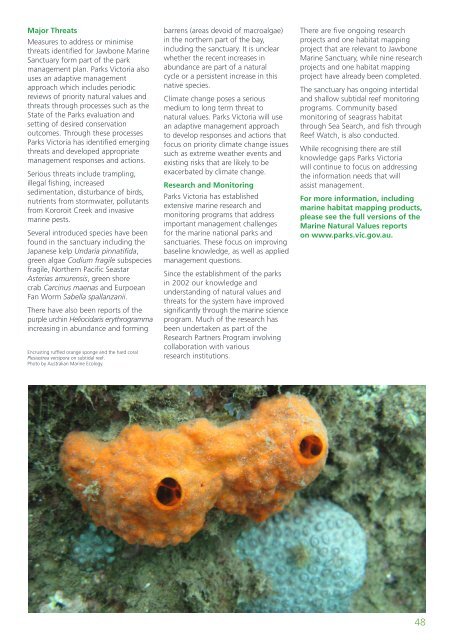Marine Natural Values Study Summary - Parks Victoria
Marine Natural Values Study Summary - Parks Victoria
Marine Natural Values Study Summary - Parks Victoria
You also want an ePaper? Increase the reach of your titles
YUMPU automatically turns print PDFs into web optimized ePapers that Google loves.
Major ThreatsMeasures to address or minimisethreats identified for Jawbone <strong>Marine</strong>Sanctuary form part of the parkmanagement plan. <strong>Parks</strong> <strong>Victoria</strong> alsouses an adaptive managementapproach which includes periodicreviews of priority natural values andthreats through processes such as theState of the <strong>Parks</strong> evaluation andsetting of desired conservationoutcomes. Through these processes<strong>Parks</strong> <strong>Victoria</strong> has identified emergingthreats and developed appropriatemanagement responses and actions.Serious threats include trampling,illegal fishing, increasedsedimentation, disturbance of birds,nutrients from stormwater, pollutantsfrom Kororoit Creek and invasivemarine pests.Several introduced species have beenfound in the sanctuary including theJapanese kelp Undaria pinnatifida,green algae Codium fragile subspeciesfragile, Northern Pacific SeastarAsterias amurensis, green shorecrab Carcinus maenas and EurpoeanFan Worm Sabella spallanzanii.There have also been reports of thepurple urchin Heliocidaris erythrogrammaincreasing in abundance and formingEncrusting ruffled orange sponge and the hard coralPlesiastrea versipora on subtidal reef.Photo by Australian <strong>Marine</strong> Ecology.barrens (areas devoid of macroalgae)in the northern part of the bay,including the sanctuary. It is unclearwhether the recent increases inabundance are part of a naturalcycle or a persistent increase in thisnative species.Climate change poses a seriousmedium to long term threat tonatural values. <strong>Parks</strong> <strong>Victoria</strong> will usean adaptive management approachto develop responses and actions thatfocus on priority climate change issuessuch as extreme weather events andexisting risks that are likely to beexacerbated by climate change.Research and Monitoring<strong>Parks</strong> <strong>Victoria</strong> has establishedextensive marine research andmonitoring programs that addressimportant management challengesfor the marine national parks andsanctuaries. These focus on improvingbaseline knowledge, as well as appliedmanagement questions.Since the establishment of the parksin 2002 our knowledge andunderstanding of natural values andthreats for the system have improvedsignificantly through the marine scienceprogram. Much of the research hasbeen undertaken as part of theResearch Partners Program involvingcollaboration with variousresearch institutions.There are five ongoing researchprojects and one habitat mappingproject that are relevant to Jawbone<strong>Marine</strong> Sanctuary, while nine researchprojects and one habitat mappingproject have already been completed.The sanctuary has ongoing intertidaland shallow subtidal reef monitoringprograms. Community basedmonitoring of seagrass habitatthrough Sea Search, and fish throughReef Watch, is also conducted.While recognising there are stillknowledge gaps <strong>Parks</strong> <strong>Victoria</strong>will continue to focus on addressingthe information needs that willassist management.For more information, includingmarine habitat mapping products,please see the full versions of the<strong>Marine</strong> <strong>Natural</strong> <strong>Values</strong> reportson www.parks.vic.gov.au.48
















